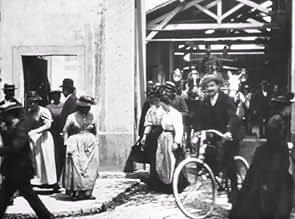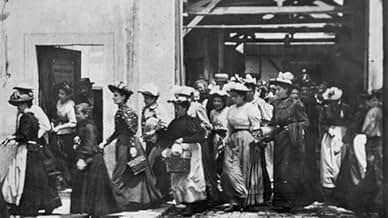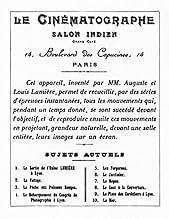Arbeiter verlassen die Lumière-Werke
Originaltitel: La sortie de l'usine Lumière à Lyon
IMDb-BEWERTUNG
6,8/10
8053
IHRE BEWERTUNG
Füge eine Handlung in deiner Sprache hinzuWorkers leaving the Lumière factory for lunch in Lyon, France in 1895; a place of great photographic innovation and one of the birth places of cinema.Workers leaving the Lumière factory for lunch in Lyon, France in 1895; a place of great photographic innovation and one of the birth places of cinema.Workers leaving the Lumière factory for lunch in Lyon, France in 1895; a place of great photographic innovation and one of the birth places of cinema.
- Regie
Empfohlene Bewertungen
Forget the "twists" you've seen in films like Psycho (1960), The Sixth Sense(1999), and the Crying Game(1992), LEAVING THE LUMIERE FACTORY (1895) blows those plot points out of the water and takes it rightful place as the biggest shock in movie history.
December 28, 1895, The Grand Cafe' in Paris, France. Only 33 out of 100 tickets are sold to the first ever demonstration of the Lumiere Cinematograph. A jaded, French crowd sits in the theater waiting to see this mystery invention they know nothing about. The lights go down. A static, barren shot of the front door of a factory is projected onto the screen. Several seconds go by before a man stands up and shouts in disappointment, "It's just the old Magic Lantern!" (the magic lantern was a primitive slide projector for still photographs) Suddenly, the doors of the factory on screen miraculously swing open, a crowd of women pour out into the frame and a seizure of--believe it or not!--motion happens within the picture. Needless to say, the audience was caught completely off guard, and were absolutely dumbstruck.
Can you imagine it?! The audience had co clue that the picture would move! They must have went bonkers! It would be like you watching Jerry Maguire, and then Tom Cruise walks right out of the screen and sits down next to you!
When those French ladies opened the doors to the Lumiere Factory, they were also opening the doors to a whole new world of art and entertainment!
December 28, 1895, The Grand Cafe' in Paris, France. Only 33 out of 100 tickets are sold to the first ever demonstration of the Lumiere Cinematograph. A jaded, French crowd sits in the theater waiting to see this mystery invention they know nothing about. The lights go down. A static, barren shot of the front door of a factory is projected onto the screen. Several seconds go by before a man stands up and shouts in disappointment, "It's just the old Magic Lantern!" (the magic lantern was a primitive slide projector for still photographs) Suddenly, the doors of the factory on screen miraculously swing open, a crowd of women pour out into the frame and a seizure of--believe it or not!--motion happens within the picture. Needless to say, the audience was caught completely off guard, and were absolutely dumbstruck.
Can you imagine it?! The audience had co clue that the picture would move! They must have went bonkers! It would be like you watching Jerry Maguire, and then Tom Cruise walks right out of the screen and sits down next to you!
When those French ladies opened the doors to the Lumiere Factory, they were also opening the doors to a whole new world of art and entertainment!
Even as the first film to come to cinema, it's still better than a lot of the films that come out today. The origin story of this film is completely fascinating. An unknowing audience attend the cinema assuming it will be a series of still images, until they get hit with the greatest twist of all time - a moving picture. The 33/100 who went to see this film are some of the luckiest people of all time, just imagine their shock.......
This is it!! if your looking for a thrilling few minutes of the French leaving work then it does not get any better than this.Action to look out for includes,
French woman walking at the screen, French bloke wobbling on his bike, The closing of the gates cliff-hanger Finale.
Oh and its maybe the most important few minutes in the history of cinema.
French woman walking at the screen, French bloke wobbling on his bike, The closing of the gates cliff-hanger Finale.
Oh and its maybe the most important few minutes in the history of cinema.
For almost anyone with an interest in the earliest motion pictures, watching this footage of workers leaving the Lumière factory never gets old. Its historical significance, as the first movie that Louis Lumière showed at the first public demonstration of his cinematograph, would certainly make it well worth remembering for that reason alone. But beyond Lumière's visionary and technical abilities, he also had a knack for choosing material for his features that was interesting in itself.
This particular subject could not have been more appropriate for his first public presentation. The seemingly simple footage is almost a microcosm of the new world created by cinema. The widely varying reactions of the various workers (not to mention the occasional dog) contain almost every common reaction to the camera: some are curious and don't mind showing it, some are curious and pretend not to be, some are a little uncomfortable, some seem to be fascinated by having their picture taken. With the 'cast' as large as it is, you can watch the film a good number of times and still not lose interest.
Beyond that, the way that the camera field is set up shows an innate sense of the value of movement, particularly movement towards the camera, in holding the attention of the audience. Some of Lumière's best films made further use of this idea.
In one very short movie, this film preserves an important step in cinema history, while also containing material that, in a sense, portrays and foresees many of the future effects of the Lumière brothers' invention. That we can experience both, any time that we view this footage of these long-past men and women and their honest reactions to the camera, is still fascinating.
This particular subject could not have been more appropriate for his first public presentation. The seemingly simple footage is almost a microcosm of the new world created by cinema. The widely varying reactions of the various workers (not to mention the occasional dog) contain almost every common reaction to the camera: some are curious and don't mind showing it, some are curious and pretend not to be, some are a little uncomfortable, some seem to be fascinated by having their picture taken. With the 'cast' as large as it is, you can watch the film a good number of times and still not lose interest.
Beyond that, the way that the camera field is set up shows an innate sense of the value of movement, particularly movement towards the camera, in holding the attention of the audience. Some of Lumière's best films made further use of this idea.
In one very short movie, this film preserves an important step in cinema history, while also containing material that, in a sense, portrays and foresees many of the future effects of the Lumière brothers' invention. That we can experience both, any time that we view this footage of these long-past men and women and their honest reactions to the camera, is still fascinating.
10jhaugh
All films made before 1912 really need to be viewed with a sense of time and place.
In 1894, the Lumiere-family men [father: Antoine (1840-1911), sons: Auguste and Louis] owned and managed a factory that manufactured photographic plates and paper. Not a small enterprise; the factory had more than 200 employees who received pension and social security benefits - innovative for that time. It was located at Montplaisir in the suburbs of Lyon, France. What caused Louis Lumiere to become interested in building a Cinematagraph, in 1894, remains open for speculation. My suggestion is that the appearance of the Edison organization's Kinetoscope (peep-show machine), in Paris during the fall of 1894, provided the catalyst.
W.K.L. Dickson, of Edison's staff, invented a motion-picture camera about the size of an upright piano that was patented in February 1893. It was electrically operated (using power from from heavy storage batteries. This massive machine pumped celluloid film strip (newly developed by the Eastman company) past a lens at about 40 frames-per-second (fps). It was ensconced, as an almost immovable object, in the "Black Maria" (essentially the first movie studio.) The Kinetescope machines showed staged presentations (less than one-minute long)that were filmed in this studio.
During 1894, Louis Lumiere applied himself to the task of inventing a moving-picture camera. He had determined that, even at 16 fps on celluloid film, the persistence-of-vision of the human eye/brain would allow for normal motion to be perceived. His camera, dubbed the Cinematograph, was about the size of a large shoe box and was provided with a detachable film magazine that provided storage for enough film to make a shoot last about one minute when it was had cranked past the lens at 16 fps.
The size and light weight, of the camera (it could be converted into a printer or a projector by the addition of a light source) made it portable enough that it could be taken to any location to record an event (provided there was enough sunlight available.) In the spring of 1895, Louis filmed: trick-riding by some cavalry men; a house on fire with firemen arriving and dousing the engulfed building with water; and a number of other scenes in and around Lyon. Using a Molteni bulb, he turned the camera into a projector and presented his films to scientists assembled in the reception room of the Revue Generales des Science. The images were projected on a screen five-meters distant from the lens. The screen was stretched in a doorway between two rooms. At a meeting of professional photographers, that same year, Louis photographed the arriving delegates and the same evening showed them motion pictures of their arrival.
With accolades from both the scientific and photographic communities, Louis decided to have a public exhibition of his invention by the end of the year. Since each of his films would be about one-minute long, he would need at least a dozen films to make a good presentation. For one of these films he set up his camera at the entrance to his factory, photographing the egress of employees at quitting-time.
The public venue chosen by Antoine - who offered himself as the "fairground barker" for the Cinematograph - was the Salon Indien of the Grand Cafe on the boulevard des Capucines in Paris. It was a wintry Saturday night on 28 December, 1895. As the first audience sat, they were presented with a projected view of the exterior of the Lumiere factory (with closed gates.) Some were chagrined that they were just going to see a routine slide show of Lumiere photographs. But then the crank on the camera/projector was turned and movement began. Louis had an innate sense for motion picture taking. This film has a beginning, a middle and an end. In the beginning, the doors are opened and people begin to leave their workplace; during the middle, the people stream out - with many trying to ignore the camera, and the cameraman, as they seem to be happy to leave a day of labor behind them. At the end, the gates to the factory are being closed.
And this was the first film projected for the entertainment of the general public.
In 1894, the Lumiere-family men [father: Antoine (1840-1911), sons: Auguste and Louis] owned and managed a factory that manufactured photographic plates and paper. Not a small enterprise; the factory had more than 200 employees who received pension and social security benefits - innovative for that time. It was located at Montplaisir in the suburbs of Lyon, France. What caused Louis Lumiere to become interested in building a Cinematagraph, in 1894, remains open for speculation. My suggestion is that the appearance of the Edison organization's Kinetoscope (peep-show machine), in Paris during the fall of 1894, provided the catalyst.
W.K.L. Dickson, of Edison's staff, invented a motion-picture camera about the size of an upright piano that was patented in February 1893. It was electrically operated (using power from from heavy storage batteries. This massive machine pumped celluloid film strip (newly developed by the Eastman company) past a lens at about 40 frames-per-second (fps). It was ensconced, as an almost immovable object, in the "Black Maria" (essentially the first movie studio.) The Kinetescope machines showed staged presentations (less than one-minute long)that were filmed in this studio.
During 1894, Louis Lumiere applied himself to the task of inventing a moving-picture camera. He had determined that, even at 16 fps on celluloid film, the persistence-of-vision of the human eye/brain would allow for normal motion to be perceived. His camera, dubbed the Cinematograph, was about the size of a large shoe box and was provided with a detachable film magazine that provided storage for enough film to make a shoot last about one minute when it was had cranked past the lens at 16 fps.
The size and light weight, of the camera (it could be converted into a printer or a projector by the addition of a light source) made it portable enough that it could be taken to any location to record an event (provided there was enough sunlight available.) In the spring of 1895, Louis filmed: trick-riding by some cavalry men; a house on fire with firemen arriving and dousing the engulfed building with water; and a number of other scenes in and around Lyon. Using a Molteni bulb, he turned the camera into a projector and presented his films to scientists assembled in the reception room of the Revue Generales des Science. The images were projected on a screen five-meters distant from the lens. The screen was stretched in a doorway between two rooms. At a meeting of professional photographers, that same year, Louis photographed the arriving delegates and the same evening showed them motion pictures of their arrival.
With accolades from both the scientific and photographic communities, Louis decided to have a public exhibition of his invention by the end of the year. Since each of his films would be about one-minute long, he would need at least a dozen films to make a good presentation. For one of these films he set up his camera at the entrance to his factory, photographing the egress of employees at quitting-time.
The public venue chosen by Antoine - who offered himself as the "fairground barker" for the Cinematograph - was the Salon Indien of the Grand Cafe on the boulevard des Capucines in Paris. It was a wintry Saturday night on 28 December, 1895. As the first audience sat, they were presented with a projected view of the exterior of the Lumiere factory (with closed gates.) Some were chagrined that they were just going to see a routine slide show of Lumiere photographs. But then the crank on the camera/projector was turned and movement began. Louis had an innate sense for motion picture taking. This film has a beginning, a middle and an end. In the beginning, the doors are opened and people begin to leave their workplace; during the middle, the people stream out - with many trying to ignore the camera, and the cameraman, as they seem to be happy to leave a day of labor behind them. At the end, the gates to the factory are being closed.
And this was the first film projected for the entertainment of the general public.
Wusstest du schon
- WissenswertesIt was the first film ever to be projected to a paying audience.
- Alternative VersionenThree versions of the film exist. There are a number of differences between them, such as the clothing styles worn by the workers change to reflect the different seasons the versions were shot in, and the horse-drawn carriage that appears in the first version is pulled by one horse, two horses in the second version, and no horse and no carriage in the third version.
- VerbindungenEdited into The Lumière Brothers' First Films (1996)
Top-Auswahl
Melde dich zum Bewerten an und greife auf die Watchlist für personalisierte Empfehlungen zu.
Details
- Erscheinungsdatum
- Herkunftsland
- Offizielle Standorte
- Sprache
- Auch bekannt als
- Arbeiter beim Verlassen einer Fabrik
- Drehorte
- Produktionsfirma
- Weitere beteiligte Unternehmen bei IMDbPro anzeigen
- Laufzeit
- 1 Min.
- Farbe
- Sound-Mix
- Seitenverhältnis
- 1.33 : 1
Zu dieser Seite beitragen
Bearbeitung vorschlagen oder fehlenden Inhalt hinzufügen




















